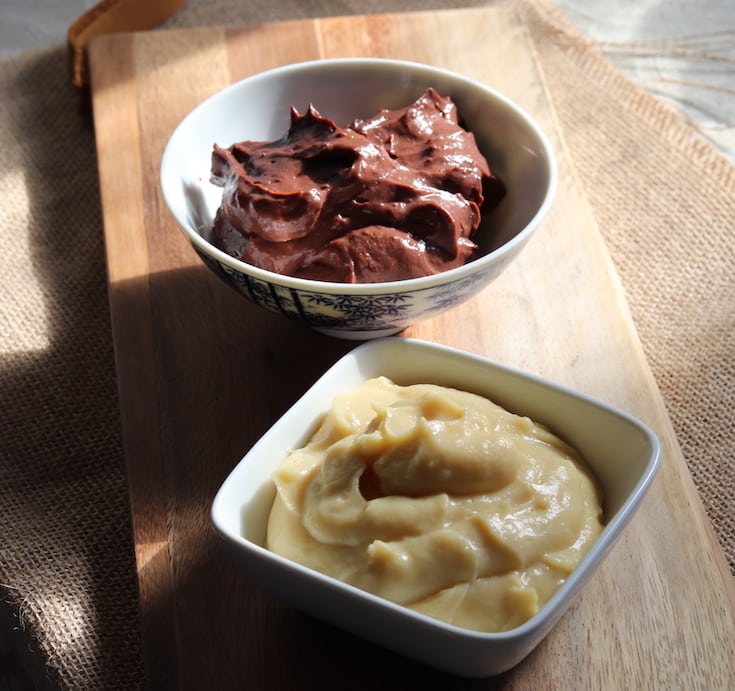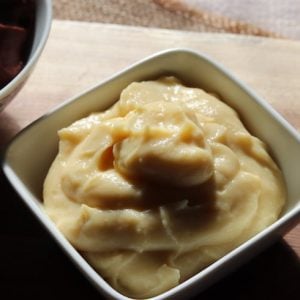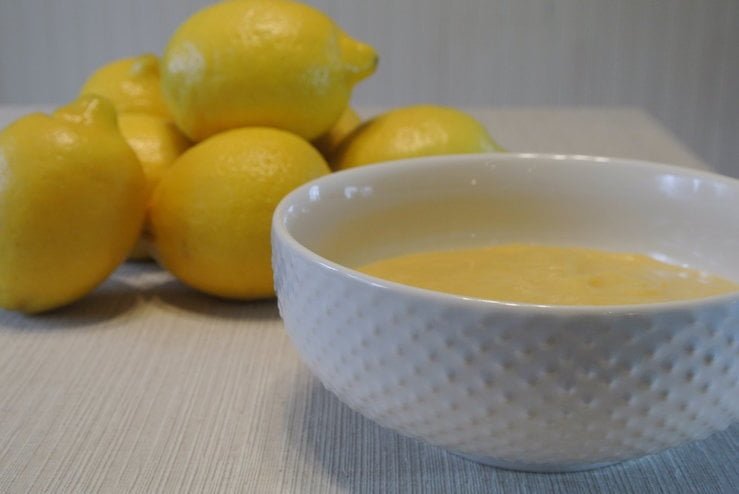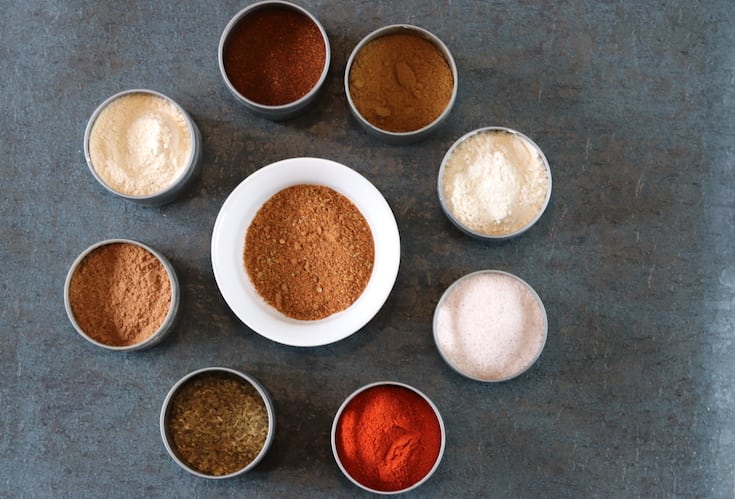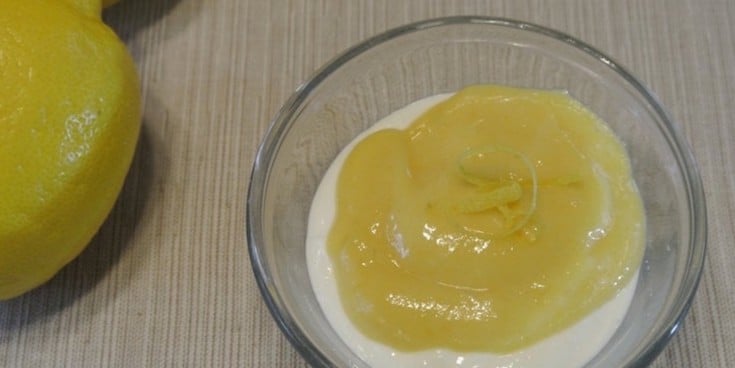Pudding is one of the ultimate comfort foods, in my opinion. Homemade pudding even more so! Although pudding is clearly a dessert, I have always been drawn to it in times of sickness or when recovering from surgery or injury. When it seems like too much effort to eat “real” food, pudding is there for you.
For most of my life, I relied upon those little boxes of pudding mix (and occasionally those plastic cups of pudding at the store). Pour the contents of the box in a sauce pan, add milk, and stand over the pot and stir for 5-10 minutes. If you have been reading my blog for some time, you probably know where I am going with this. 😉 Do you have any idea what those boxes of pudding contain? If not, let me enlighten you below. I will also cover those little plastic cups of “pudding”. First, though, I need to tell you that those boxes are absolutely NOT any faster than making pudding at home. Homemade pudding joins the ranks of homemade mayo and homemade salad dressing, in that they are all so easy to make and take only a few minutes each. Also, by making homemade pudding, you can turn a treat into a way to get healthy fats, gut-healing gelatin, and many important nutrients into your body.
Ingredients in boxed “pudding”:
- Refined Sugar: This one is not too surprising. In the version we will make here today, we will use maple syrup instead of refined sugar and gain some trace minerals in the process.
- Modified cornstarch: This is made from genetically modified corn (as is all corn syrup, high fructose corn syrup, etc.) For our version today, we will use organic cornstarch to ensure that we are not eating genetically modified corn. If you have a corn sensitivity or allergy (many do without even being aware of it), you can substitute arrowroot powder.
- Tetrasodium Pyrophosphate and/or Disodium Phosphate: These are emulsifiers and thickeners and are both “generally recognized as safe” by the FDA as long as they are consumed in minute amounts. At least that is what they say now. Who knows what they will say in 10 years? Since real pudding uses nutritious ingredients to make it thick and creamy, I will skip these two just to be on the safe side.
- BHA: This preservative is in potato chips, cereals, dessert mixes, and many other processed products. It is “reasonably assumed to be a human carcinogen” by the National Institute of Health and yet is “generally recognized as safe” by the FDA. Hmmm. I think I will err on the side of caution here.
- Food Coloring: (Vanilla: Yellow 5 and Yellow 6. Chocolate: red 40, yellow 5, blue 1) Food colorings are linked with tumor growth, allergic reactions, and hyperactivity. Go here for an in-depth look at why you should avoid eating foods with food coloring.
- Mono and Diglycerides (for Chocolate pudding): These are emulsifiers that contain small amounts of trans fats. The FDA ban doesn’t apply to these because they are not classified as lipids. Trans fats should be avoided like the plague they are, even in small amounts!
- Alkalized (or Dutch-processed) Cocoa powder: This isn’t especially unhealthy, but the alkalizing process removes many of the nutrients.
Ingredients in plastic cups of “pudding”:
Let me first start off by saying that some of these things need no refrigeration! A “dairy” product that needs no refrigeration is a red flag for me! If it isn’t for you, maybe some of the ingredients listed below will be.
- Nonfat milk or skim milk: You should never consume non-fat or skim dairy products. Go here for an in-depth discussion on why doing so will make you fat and harm your health!
- Refined sugar: This one is not too surprising. In the version we will make here today, we will use maple syrup instead of refined sugar and gain some trace minerals in the process.
- Modified cornstarch: This is made from genetically modified corn (as is all corn syrup, high fructose corn syrup, etc.) For our version today, we will use organic cornstarch to ensure that we are not eating genetically modified corn. If you have a corn sensitivity or allergy (many do without even being aware of it), you can substitute arrowroot powder.
- Natural and Artificial flavors: A natural flavor isn’t what is sounds like. The term can hide anywhere from 50-100 ingredients!! (source) Most natural flavoring is a lab-derived flavoring that at one point in time in history had been taken out of a real food. They can then be chemically modified. After that, they add solvents and preservatives that you most likely wouldn’t want to consume if you knew they were in there.
- Sodium Stearoyl Lactylate (SSL): Some people have sensitivities or allergies to this that causes an increase in mucus production or digestive reactions.
- Food Coloring: Food colorings are linked with tumor growth, allergic reactions, and hyperactivity. Go here for an in-depth look at why you should avoid eating foods with food coloring.
- Vitamin A Palmitate and Vitamin D: These pudding cups have been “enriched” with synthetic vitamins. Synthetic vitamins for the most part are not received by your body. Your body then has to use its detox pathways to eliminate these “vitamins” from your system. This keeps your body busy when it could be doing other more important repairs for you. This article and this article provide more in depth explanations about why it is important to avoid synthetic vitamins (both in enriched foods and in the actual supplements that you purchase.)
- Hydrogenated vegetable oil: You probably already know that trans-fats raise our bad cholesterol and lower our good cholesterol and are associated with weight gain.
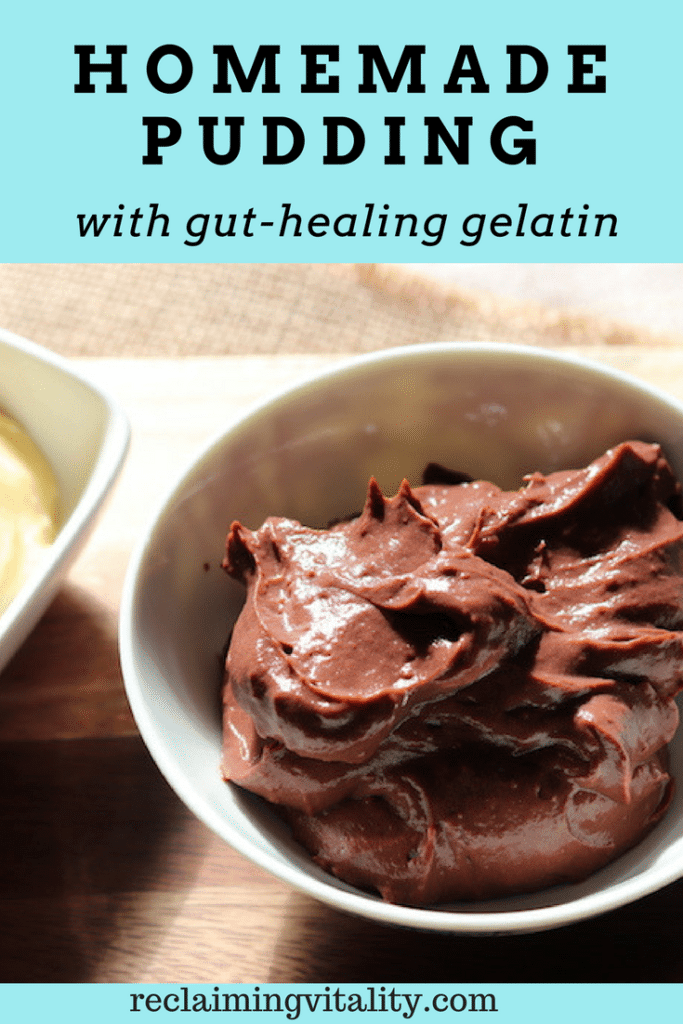
What is in Homemade Pudding that makes it Nutritious?
As you can see from above, what isn’t in homemade pudding is pretty important, but what is in homemade pudding is equally important.
- Grass-fed whole milk (non-homogenized): Whole non-homogenized milk from grass-fed cows is full of healthy fats, conjugated linoleic acid (CLA), plus real calcium and vitamin D (not synthetic).
- Pasture-raised egg yolks: Omega 3’s (Important for brain and mood health), Vitamin E (An antioxidant that helps repair cellular damage, vitamin D (important for immunity and mood), vitamin K2 (harder to get in your diet unless you eat liver and plenty of dark leafy greens), choline (crucial to cognitive function and bile production.)
- Grass-fed gelatin: Known for it’s ability to heal the gut and help with digestion. In addition, grass-fed gelatin improves joint health, sleep quality, mood and cognitive function, as well as skin and cardiovascular health. Go here for a more in-depth look at grass-fed gelatin’s benefits.
- Organic cornstarch (or arrowroot powder): Here we are trading out genetically modified cornstarch for the organic (and not messed around with) version.
- Organic maple syrup: We have traded in refined sugar which is full of empty calories for maple syrup in order to gain important trace minerals
- Fine sea salt: Loaded with trace minerals, unlike table salt (iodized or not).
- Organic cocoa powder (for chocolate pudding): We are trading in the alkalized cocoa powder for a more nutritious version
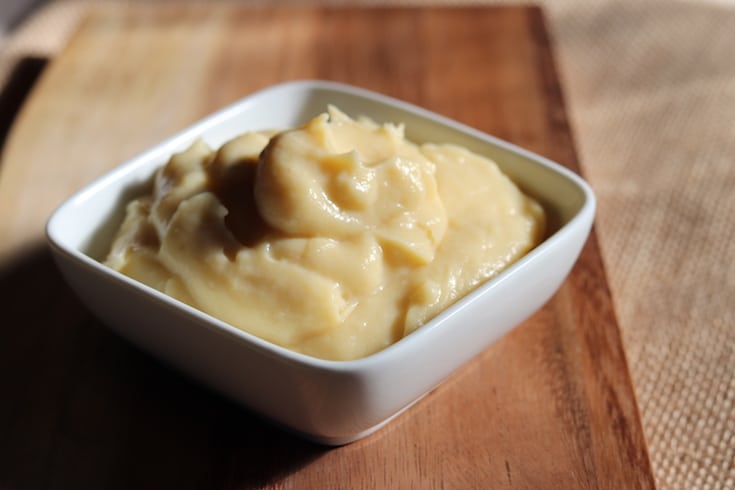
Basic Homemade Pudding (vanilla):
- 2.5 cups whole, non-homogenized, grass-fed milk
- 1 tablespoon grass-fed gelatin
- 1/4 teaspoon fine sea salt
- 3 tablespoons organic cornstarch (use arrowroot if you have a corn sensitivity)
- 3 pastured egg yolks and 1 whole pastured egg
- 1 teaspoon vanilla extract
- 1/3 cup plus 1 tablespoon organic maple syrup
Directions for homemade pudding:
- In a medium saucepan, off heat, whisk together gelatin, cornstarch and salt.
- Gradually whisk in milk.
- Once the gelatin, cornstarch, and salt are dissolved then whisk in egg, yolks, and maple syrup.
- Turn heat on to medium and whisk fairly constantly.
- The mixture will thicken and come to a boil. When it does, reduce heat to low.
- Cook 1 more minute, whisking constantly.
- Remove from heat, add vanilla, and pour through a metal sieve into bowl.
- If serving cold, chill at least 3 hours. If desired, remove pudding “skin” and whisk the pudding until smooth before serving.
To make homemade chocolate pudding:
Follow the directions above, but add 1/3 cup of cocoa powder in the beginning when you add the gelatin, cornstarch, and salt.
Homemade Pudding with gut-healing gelatin
Ingredients
- 2.5 cups whole non-homogenized grass-fed milk
- 1 tablespoon grass-fed gelatin
- 1/4 teaspoon fine sea salt
- 3 tablespoons organic cornstarch use arrowroot if you have a corn sensitivity
- 3 pastured egg yolks and 1 whole pastured egg
- 1 teaspoon vanilla extract
- 1/3 cup plus 1 tablespoon organic maple syrup
Instructions
- In a medium saucepan, off heat, whisk together gelatin, cornstarch and salt.
- Gradually whisk in milk.
- Once the gelatin, cornstarch, and salt are dissolved then whisk in egg, yolks, and maple syrup.
- Turn heat on to medium and whisk fairly constantly.
- The mixture will thicken and come to a boil. When it does, reduce heat to low.
- Cook 1 more minute, whisking constantly.
- Remove from heat, add vanilla, and pour through a metal sieve into bowl.
- If serving cold, chill at least 3 hours. If desired, remove pudding "skin" and whisk the pudding until smooth before serving.
Notes
- Is pudding a comfort food for you? Do you make homemade pudding? Have you ever made your own?
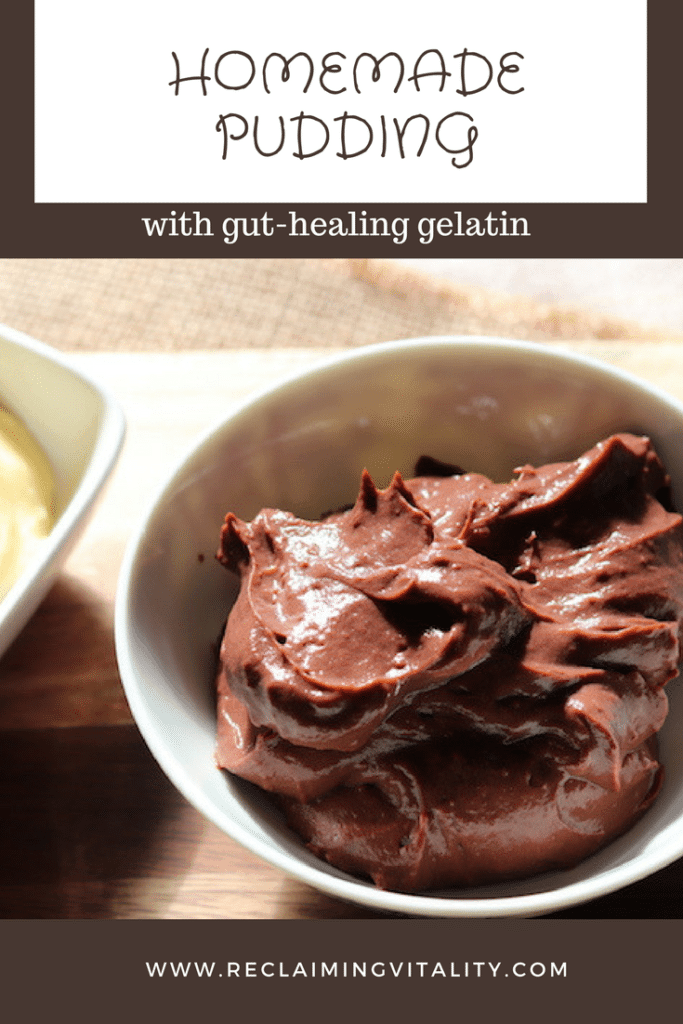
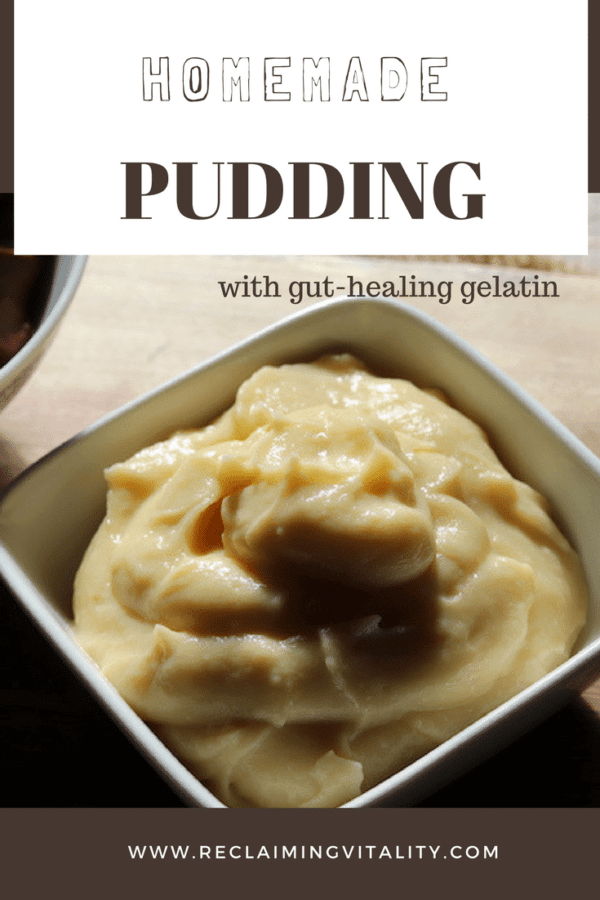
Keep in touch!
We love pinning on Pinterest!
However, our favorite way to keep in touch is through email! Subscribe and never miss a post. Plus, get access to the Holistic Health Resource Library. There you can download ebooks, PDFs, and Homeopathic Remedy Cards by condition for FREE!
You will also get emails with information on how to incorporate true holistic healing into your life. Absolutely no spam!

